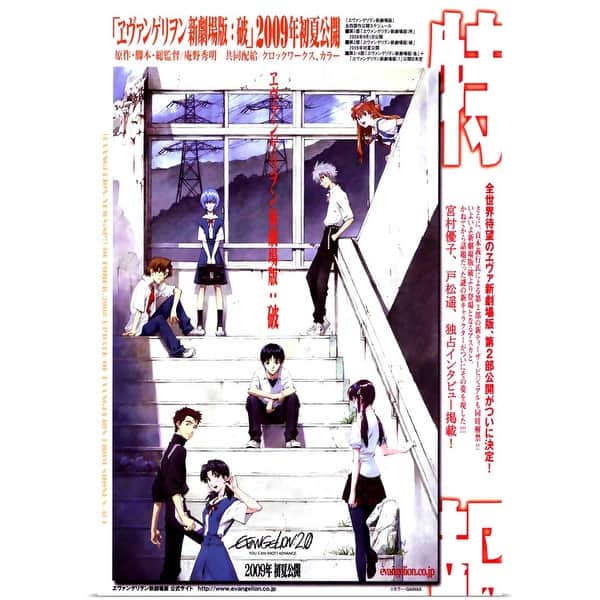
End of Evangelion: Angels, Symbolism, and the Legacy of Neon Genesis E
A Journey Beyond Anime – Introduction
Few anime series have left a mark on pop culture quite like Neon Genesis Evangelion. Originally airing in 1995, the series redefined what anime could be, mixing giant mecha battles with deep psychological and philosophical themes. For many fans, however, the true culmination of the story arrived with End of Evangelion (1997) — a movie that shocked audiences, divided opinions, and cemented Evangelion’s status as a cultural icon.
More than just an alternate ending to the TV series, End of Evangelion became a statement about depression, loneliness, human connection, and survival. Its imagery of Angels, the tragedy of Shinji, the mystery of Kawoshin, and the surreal beauty of Ramiel continue to inspire discussion among fans worldwide.

End of Evangelion movie poster
Evangelion 1 and the Origins of the Series
Before End of Evangelion shook the anime world, it’s important to look back at the roots. Neon Genesis Evangelion began as a 26-episode TV series directed by Hideaki Anno. It quickly stood out from typical mecha anime, diving into themes of identity, trauma, and existential dread.
Later, the Rebuild of Evangelion films began with Evangelion 1.0: You Are (Not) Alone. This movie retold the early episodes with modern animation, bringing new fans into the universe while setting the stage for the more complex entries to come. For newcomers, Evangelion 1 served as a gateway to the larger mythos that eventually leads to End of Evangelion.

Evangelion 1.0 poster
End of Evangelion – The Controversial Finale
A Bold Alternative Ending
When the original TV series concluded, many fans were left confused. The final two episodes abandoned traditional storytelling in favor of abstract introspection. To address this, Anno created End of Evangelion, delivering a raw and uncompromising conclusion.
The movie showcased humanity’s confrontation with the “Human Instrumentality Project” and Shinji’s ultimate choices. Instead of neat closure, fans were confronted with surreal imagery, graphic violence, and questions about existence itself.
Fan Reactions Around the World
The result? Division. Some called it a masterpiece; others were left baffled. Yet, this controversy only fueled Evangelion’s legend. Over two decades later, End of Evangelion is still discussed, studied, and celebrated in anime circles across the globe.
[[Image: Shinji in End of Evangelion]]
Evangelion Angels and Their Symbolism
What Are the Angels?
In Evangelion, the Angels aren’t simple villains — they’re mysterious beings with cryptic designs and godlike powers. Each Angel carries heavy symbolic weight, often tied to biblical or mythological references. They are challenges not only to humanity’s survival, but also to the psyche of each pilot.
Ramiel – The Geometric Angel
Among the most iconic Angels is Ramiel, a glowing geometric prism whose laser attacks remain unforgettable. Ramiel represents the idea of perfection and fear of the unknown. Its minimal design, combined with haunting sound effects, makes it one of Evangelion’s most striking adversaries.
The fight against Ramiel is remembered as a defining moment in the series — not only visually stunning but also emotionally charged, showing the desperation and determination of the characters.
Kawoshin – A Connection That Defined Evangelion
For many fans, Evangelion’s emotional heart lies in the bond between Shinji Ikari and Kaworu Nagisa. Kaworu, the Fifth Child, appears briefly yet leaves a lasting impression. His empathy, warmth, and eventual sacrifice reshaped Shinji’s journey.
The fan-favorite pairing, often referred to as Kawoshin, became a cornerstone of Evangelion’s legacy. For LGBTQ+ fans especially, Kawoshin represented a rare and meaningful connection in anime at the time. Beyond romance or friendship, Kaworu gave Shinji a glimpse of unconditional acceptance.

Shinji and Kaworu playing the piano
The Cultural Impact of End of Evangelion
Influence on Anime & Beyond
End of Evangelion didn’t just end a series — it influenced an entire industry. Its bold storytelling inspired creators across anime, film, and even video games. From surreal visuals to emotionally raw characters, Evangelion’s DNA can be found in countless works that followed.
A Timeless Discussion
Over 25 years later, debates about the movie’s meaning continue. Was it hopeful? Nihilistic? Both? That enduring ambiguity keeps fans engaged. From forums to YouTube essays, from academic papers to fan art, End of Evangelion refuses to fade into history.
Why Fans Still Wear Evangelion Today
For the global fandom, Evangelion isn’t just something you watch — it’s something you live. Fans carry the series with them through art, memes, and fashion. Wearing an Evangelion hoodie or shirt featuring Shinji, Kaworu, or Ramiel is more than just style; it’s a way to connect with a story that shaped anime history.
At LittleOwh, our anime hoodies, joggers, and sneakers let fans express their passion every day. Whether you’re drawn to the eerie majesty of the Angels or the emotional resonance of Kawoshin, there’s a design that speaks to you.

Asuka Langley Soryu Hoodie Neon Genesis Evangelion Anime Casual Cosplay Costume
Conclusion – The Eternal Legacy of End of Evangelion
End of Evangelion is more than a movie. It’s a conversation — one that never truly ends. With its Angels like Ramiel, the emotional weight of Kawoshin, and its daring vision, it pushed anime into new territory.
For fans, revisiting Evangelion is like peeling back endless layers of meaning. And for new generations, the series still feels fresh, relevant, and powerful.
✨ Discover Evangelion-inspired fashion at LittleOwh. Whether you’re a longtime fan or just beginning your journey, our anime hoodies and outfits are made to keep the legacy alive in your everyday style.
SHARE
Leave a comment
Related post
SUBSCRIBE & GET FREE SHIPPING
Get a FREE shipping code when you subscribe.





